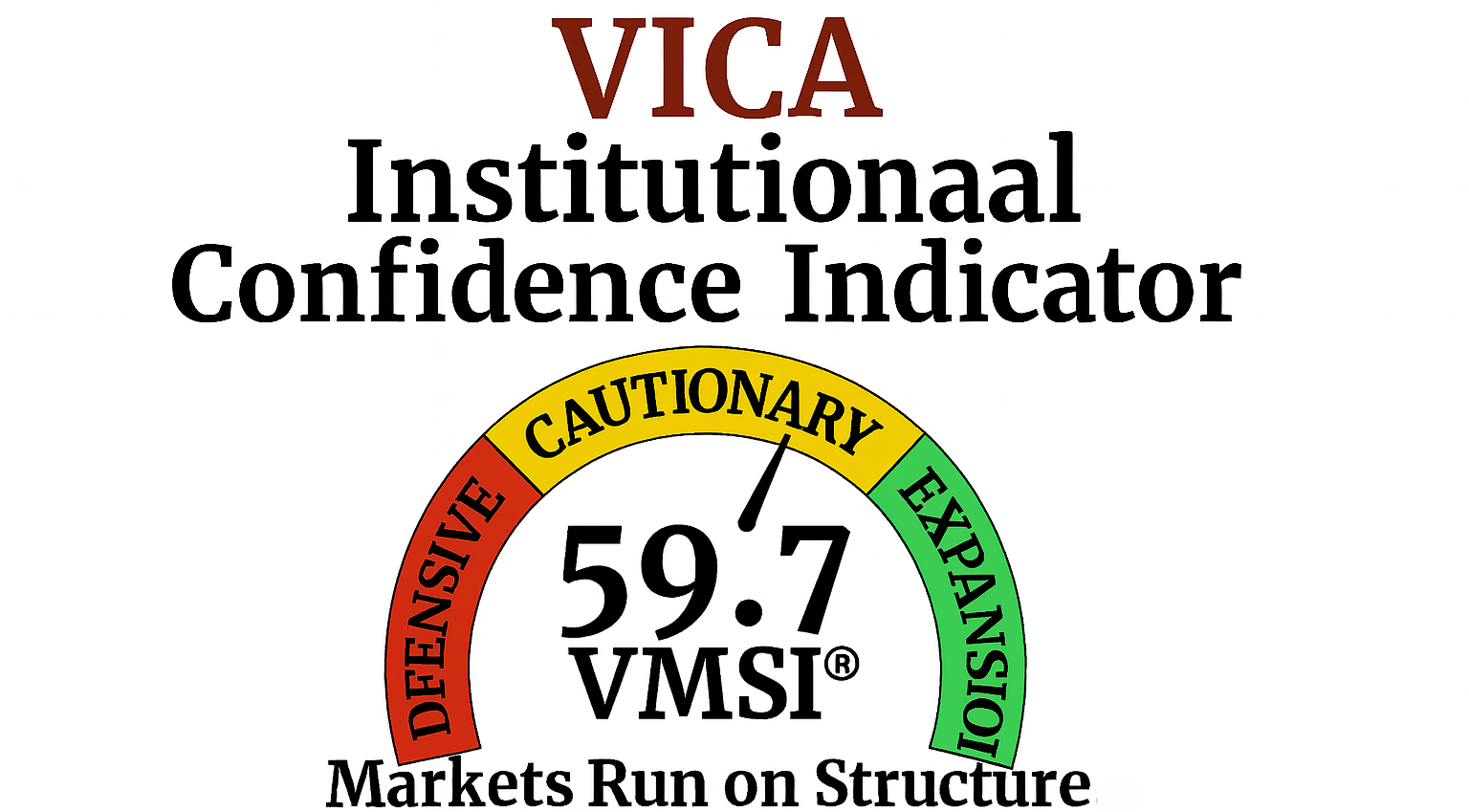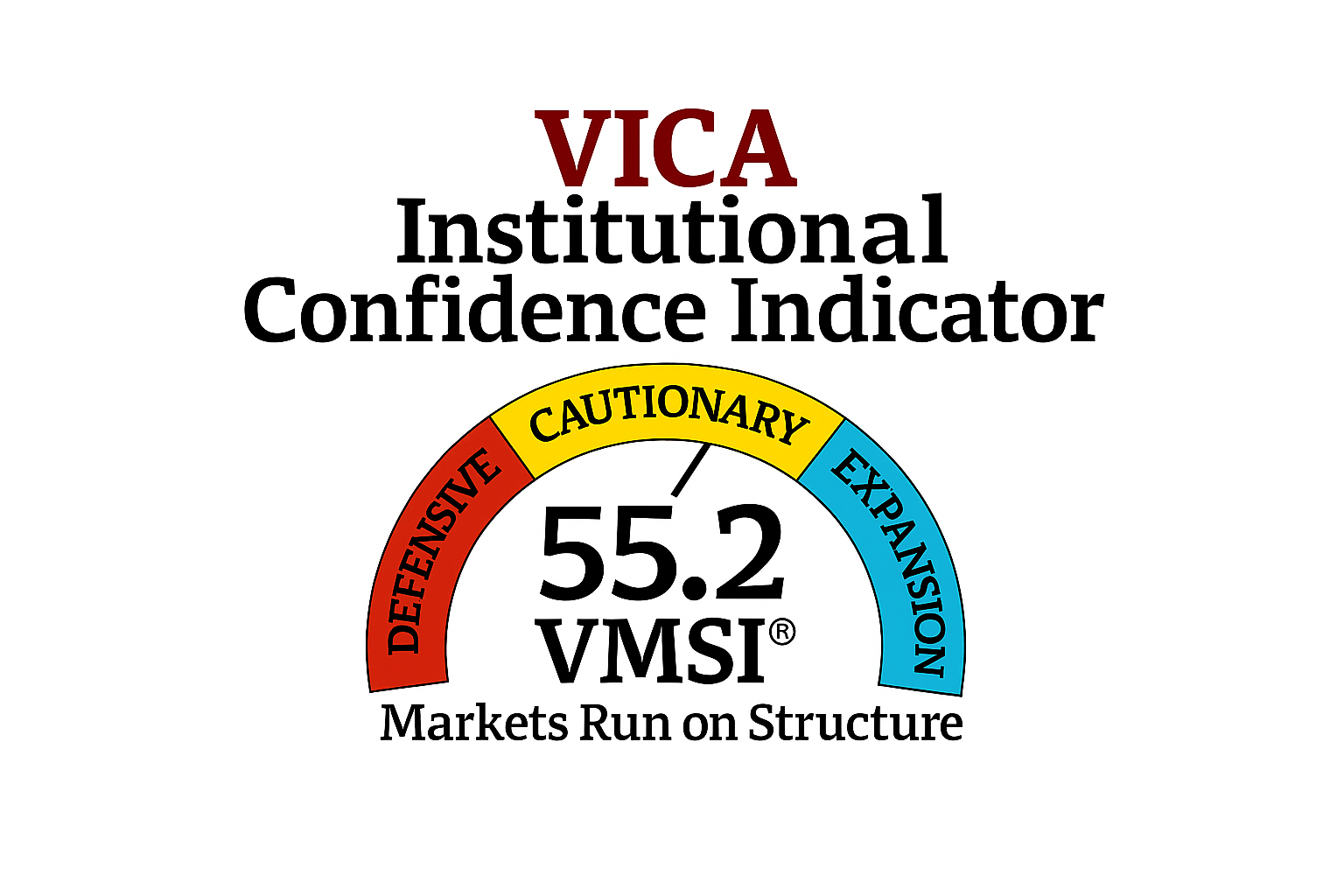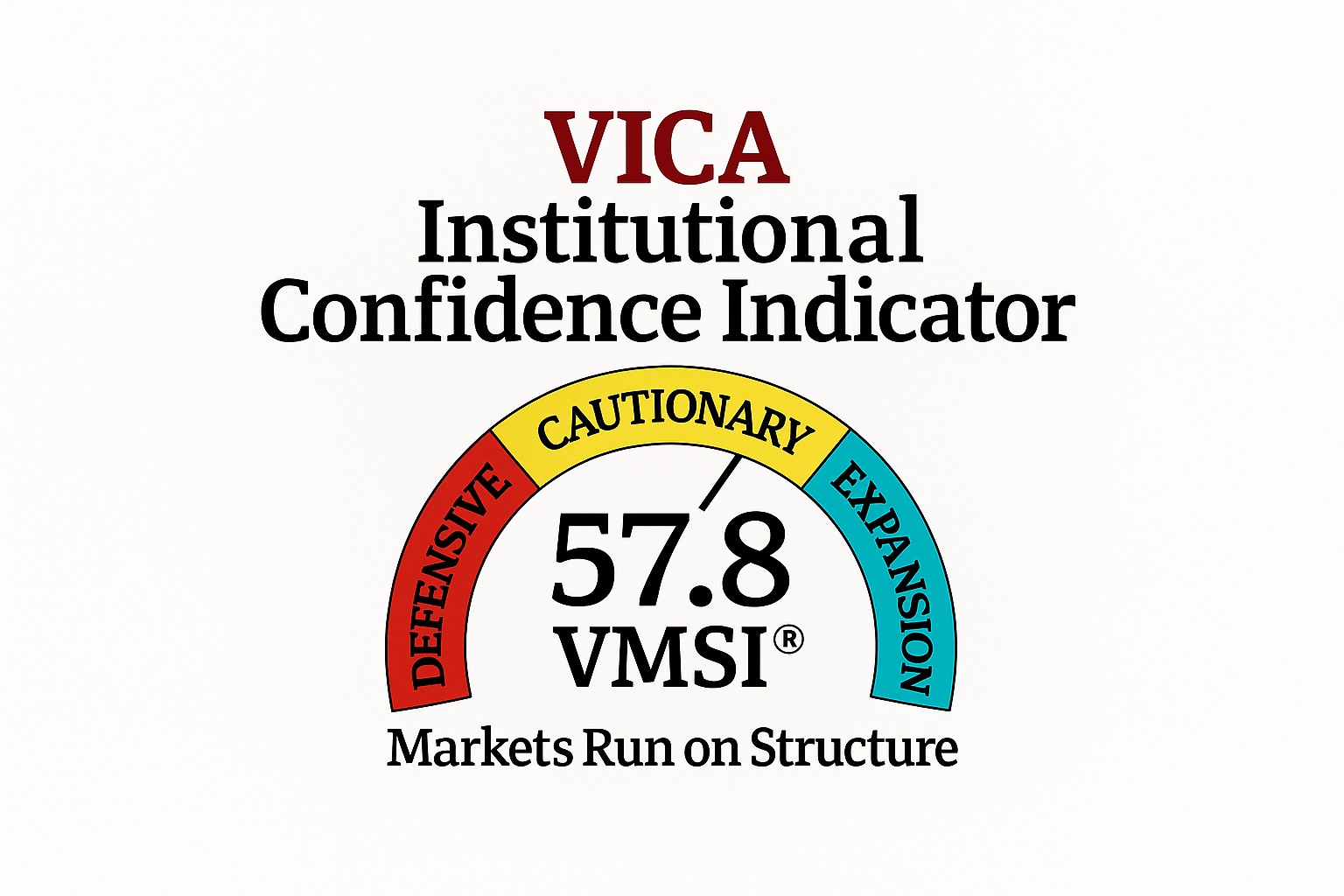VMSI™ Institutional Market Intelligence Report — FORCE-12.2 Institutional Edition
Week Ending October 23, 2025
The Persistence Premium
Liquidity Buys Time — Credit Prices the Future
Markets remain stable, but the margin for error is narrowing. Liquidity holds valuations aloft, with the S&P 500 near 20.2× forward earnings, its highest since 2021, while the NASDAQ’s strength reflects liquidity concentration in megacaps, not broad risk appetite. Leadership is narrow as flows persist through passive and AI channels.
Regulators have flagged mid-tier banks such as First Foundation for elevated CRE exposure and unrealized losses. Roughly $1.7 trillion in CRE debt matures before 2027, mostly on regional balance sheets; office delinquencies now exceed 6%, the highest since 2012. Liquidity still functions, but incremental flow sustains valuations rather than expands them. The persistence premium endures—financed by liquidity, constrained by credit, and priced for perfection.
Weekly Summary – Week Ending October 23, 2025
The VMSI composite rose to 59.7 (from 59.4), holding well above the 58 continuation threshold. Sub-components: Liquidity 61.8 · Momentum 59.4 · Volatility & Hedging 58.6 · Safe Haven 58.9. Liquidity remains the system’s stabilizer, momentum steady, hedging balanced, and safe-haven demand firm but not stress-driven.
Macro Context: The Conference Board LEI (−0.5 % in August) confirms slower growth. Consumer Confidence 94.2 and CEO Confidence 48 (Q4) show persistent caution. Inflation (CPI +0.3 % m/m; +3.0 % y/y core and headline) keeps policy in “long-plateau” mode. Manufacturing PMI 52.2 and labor indicators signal cooling, not contraction. CRE risk remains elevated: office CMBS delinquency ≈ 11 %, bank-held CRE ≈ 1.4 % (Q2 2025)—manageable but under watch. Regulators continue to monitor mid-size lenders with concentrated CRE exposure.
Market Tone: DJIA 46,220 · S&P 6,682 · NASDAQ 22,971 · Gold $4,362 · Crude $58.1 · 10-yr UST 3.95 % · HY 339 bps · IG 110 bps · Fear & Greed 27 (Fear). Breadth modestly improved (A/D −1,102 · McClellan −63); volatility compressed (VIX 13.9 · realized vol 21st pct). Equity valuations stay elevated — S&P 500 forward P/E ≈ 22.5×, top decile of the past 15 years. Credit spreads stable (HY < 345 bps). Liquidity supportive; execution capacity strong.
Structural Takeaway: Liquidity buys time; credit prices the future. With Liquidity 61.8, markets remain in a late-compression regime—resilient yet torque-sensitive. Continuation bias persists unless HY > 345 bps or breadth < 50 %. The system absorbs stress efficiently, but further credit tightening defines the next inflection.

Framing Note — FORCE-12.2 Calibration
Reference Model: Mt = ECt × Ft⁴ × μt + Ct
Parameters: EC = Execution Capacity F = Liquidity Flow Multiplier μ = Convexity / Friction C = Crowding Torque
Calibration: Mt = 0.9012 ⇒ VMSI = 59.7M
Theoretical Note — Why FORCE-12.2 Matters : FORCE-12.2 solves for what every market theory leaves unsaid: how stability becomes fragility. It quantifies the moment when liquidity’s support turns self-defeating—when flow stops absorbing risk and begins to transmit it. By measuring that shift, the model bridges behavior and structure, showing that markets fail not from panic, but from the exhaustion of balance itself. The inflection point where liquidity’s strength becomes its risk.
1. Liquidity & Torque Dynamics — The Physics Behind 59.7
At 59.7, the system remains in compression—force still exceeds dissipation. Execution capacity = 0.95; flow multiplier F = 1.021; friction (μ) low. Liquidity 61.8 anchors market depth while credit torque tightens modestly. Skew 25th pct., realized vol 20th pct., spreads (HY 339 bps; IG 110 bps) sit within neutral zones.
Inertia 59.7 signifies digestion, not fatigue: breadth (A/D −1 102; McClellan −63) improves marginally, HY spreads up 4 bps w/w but below the 345 bps stress threshold. Liquidity continues to absorb micro-shocks from CRE and mid-cap credit without systemic leakage.
Allocator Note: Maintain a pro-liquidity stance but rotate faster through leadership. Treat 61.8 liquidity as the market’s shock absorber—effective, not infinite. Pair quality beta with convex hedges; trim duration risk only if HY curvature exceeds 345 bps or breadth momentum breaks below 50 %.
Structural Takeaway: Liquidity dominance persists—credit friction is rising but contained. Continuation bias holds until HY > 345 bps or breadth < 50 %. The system remains in a late-compression phase where liquidity stabilizes more than it stimulates.

2. Lead Insight — Market Inertia Gauge
Inertia at 59.7 reflects persistence, not stretch. Momentum (59.4) and liquidity (61.8) remain synchronized, confirming a stable energy loop between flow and execution. Participation narrowed slightly, but capital rotation velocity increased as leadership compressed into large-cap growth and high-liquidity cyclicals.
When Inertia > 58 and breadth narrows, historical continuation probability ≈ 60 %, with a 12–15 session cycle and an average +1.1 % follow-through. Volatility (21st pct.) and skew (25th pct.) remain subdued; ETF liquidity improved +2.8 % w/w, signaling that liquidity is still absorbing stress faster than credit can transmit it.
Allocator Note: Stay positioned in high-liquidity corridors; rebalance on 10–15 session rhythm. Fade defensive crowding, lean into flow density where leadership rotation remains active.
Structural Takeaway: Inertia remains positive—liquidity stable, energy compressive. Rotation persists without exhaustion, validating the late-compression continuation regime.

4. Component Deep Dive — Week-over-Week Changes

Signal: Liquidity and momentum continue to advance in tandem — the FORCE-12 axis remains aligned. Friction and torque stay within tolerance; absorption remains dominant.
Allocator Note: Add selectively on shallow pullbacks; favor quality beta within liquidity corridors; maintain convex hedges through gold and IG duration overlays. Long bonds have regained cyclical value—duration now provides convex protection and positive carry as yields stabilize below 4 %.
Structural Takeaway: The liquidity spine remains intact, reinforced by renewed duration value. Stress channels stay dormant; continuation bias persists unless HY > 345 bps or breadth < 50 %.
5. Sector Rotation & Positioning

Signal: Growth and cyclicals (Tech, Comms, Industrials, Financials) dominate market torque. Health Care moves from laggard to re-entry, offering convex upside at a decade-low valuation. Defensives and Energy remain under pressure as liquidity rotation favors high-earnings beta.
Allocator Note: Stay overweight in growth + cyclicals; add tactical Health Care exposure. Underweight defensives and Energy. Use duration and IG carry as stabilizers while HY < 345 bps and breadth > 50 %. Health Care now defines the most attractive risk-adjusted convexity in the VMSI 59.7 regime.

6. Sentiment Overview — Institutional Positioning & Market Psychology

Signal: Institutional capital continues to lead directionally, rotating within liquidity and earnings strength zones. Retail sentiment remains defensive, acting as a volatility dampener rather than a catalyst. Conviction asymmetry persists — institutions express confidence through positioning, while retail behavior maintains the system’s optionality buffer.
Allocator Note: IRSR ≈ 1.47× confirms institutional persistence; risk remains efficiently distributed. Fade fear-driven drawdowns and lean into liquidity density where participation narrows but torque remains intact.
Structural Takeaway: Liquidity continues to flow through strong institutional hands — the defining feature of the late-compression regime. Retail caution preserves upside convexity; institutional allocation sustains directional inertia.

7. Predictive Outlook — Week Ending October 23, 2025
Base Case (55 %) — Liquidity-Led Continuation FORCE-12.2 trajectory: 59.7 → 60.3 → 60.9 (4 wks). Liquidity absorption and execution capacity remain dominant; VIX < 14 keeps convexity contained. Model probability 68 % that HY spreads stay < 345 bps through mid-November, implying S&P +2–3 % drift. Fed reaction function inactive before December, sustaining the late-compression regime.
Allocator Note: Overweight IG credit / underweight HY pairs; maintain long Tech and Industrials beta hedged with volatility overlays. Duration exposure regains cyclical value as real yields plateau.
Alt Case (30 %) — Credit Bleed / Not Break Trigger zone: HY 340–355 bps · Breadth < 50 % · CPI > 3.2 %. Torque transmission rising +0.4 σ; liquidity elasticity −0.3 σ. Pattern layer flags divergence between HY spreads and NASDAQ breadth (27 % probability within 4 weeks). Short-term correlation drift suggests compression stall risk by mid-November.
Allocator Note: Tighten credit hedges via HY CDX or synthetic barbell (long IG / short HY). Add gold and 2-yr duration as low-cost convex overlays.
Extreme Case (15 %) — Convexity Event Trigger zone: HY > 365 bps · CRE delinquency > 12 % · VIX > 24 · VMSI < 56. Regulatory stress in regional banks remains contained but creeping (+20 bps q/q). Model probability 8 % of reflexive break within six weeks; expected equity adjustment −5–8 %.
Allocator Note: Shift to cash + IG carry; maintain tail-risk hedges via S&P skew and duration. Preserve optional liquidity for post-event deployment.
Timing Window: Model signal projects torque inflection probability > 30 % by Nov 15 if HY > 345 bps and breadth < 50 %. Policy lag grants ≈ 4 weeks of persistence before convexity risk rises materially.

Signal: Continuation bias holds until credit breaches the 345 bps threshold. Liquidity compression visible (−3 % efficiency w/w) but still absorptive.
Structural Takeaway: Liquidity buys time; credit prices the future. The system remains compressive but not yet reflexive. Optionality is cheap, duration is safe, and credit is the fuse that will ignite the next regime.

8. Macro Signals Snapshot — Week Ending October 23, 2025

Signal: Macro conditions remain stable but show early torque transition — demand momentum is softening while liquidity still provides cushion. The system operates in a credit-constrained equilibrium, not a dislocation phase.
Allocator Note: Maintain moderate risk while MCSI > 0.70; bias toward quality duration, IG carry, and cyclicals with liquidity depth. Fade any risk premia overshoot if HY < 345 bps.
Structural Takeaway: The macro system continues to evolve from liquidity-led resilience toward credit-defined persistence — the pre-convex stage where policy lag meets tightening torque.

9. Strategic Layers — Multi-Lens Analysis (FORCE-12.2 Structural Integration)

Signal: Multi-lens reinforcement remains intact. Flows and quality carry offset macro softening. Credit torque is the hinge variable — widening but orderly. Liquidity continues to define the equilibrium.
Allocator Note: With CAVS = 0.83 (> 0.80 threshold), exposures remain scalable but discipline is essential. Add risk on stress; trim on momentum. Preserve convexity via gold, IG carry, and long duration.
Structural Takeaway: Cross-lens alignment anchors inertia. Liquidity drives persistence — credit defines its limits. Compression holds; convexity waits.

10. Institutional Opportunities
The Krummholz Force Risk/Reward Indicator (KFRRI) continues to signal structural asymmetry. Liquidity still underwrites convex payoffs, but credit torque is tightening, and leadership is rotating from growth momentum to quality cyclicals and IG carry. The convexity vector has shifted toward financials, industrials, and long-duration quality credit, with gold and Treasuries preserving their hedge efficiency.

Signal: Cross-asset asymmetry remains investable, but dispersion is rising. Liquidity still absorbs stress efficiently, yet credit torque now shapes opportunity boundaries.
Allocator Note: Scale risk through overlays, not gross exposure. Concentrate convex capture in Industrials, Financials, IG credit, and gold; keep duration as a convex ballast.
Structural Takeaway: Liquidity continues to sustain convexity, but the fulcrum has shifted. The late-compression regime demands precision — persistence is investable only through disciplined structure and asymmetric allocation.

Final Word — Liquidity Buys Time, Not Safety
Liquidity still stabilizes the system, but it no longer compounds return — it extends duration. The market’s resilience is mechanical, not regenerative: each marginal inflow sustains structure but fails to deepen capacity.
Credit torque now defines the forward contour. The widening between liquidity depth and real risk absorption marks the quiet shift from endurance to erosion. Efficiency persists, but elasticity is thinning; valuations remain elevated against a slowing base of support.
This is the persistence premium — time purchased through liquidity, priced through credit. Stability remains investable, but not durable. The next phase will not hinge on volatility, but on the moment credit reprices time itself.
Liquidity preserves motion; credit determines meaning!
Why We Built VMSI™
VMSI™ doesn’t predict markets — it observes how conviction holds them together. Where most models chase price or sentiment, VMSI™ measures persistence: the strength that keeps motion from breaking when pressure rises.
Markets are not just numbers; they are expressions of belief under constraint. VMSI™ translates those pressures into structure — showing where confidence becomes stability and where credit begins to shape direction. Built on the basic laws of inertia, force, and friction, it turns behavior into something that can be measured, compared, and understood.
This is not a forecast. It is a framework — a way to read markets as living systems that think, adapt, and balance their own tension. When VMSI™ rises above its anchor levels, it signals endurance, not exuberance. It shows that liquidity still carries weight and that conviction still has meaning.
Positioning Note: For institutional and private investors alike, VMSI™ offers a steady lens in volatile times. It helps distinguish motion from noise, conviction from emotion, and structure from speculation.
Disclaimer: For informational purposes only — not investment advice or a solicitation. Views are as of publication and may change. Past performance is not indicative of future results.
© 2025 VICA Partners — VMSI Economic Physics Model




